June 24, 2025 | 21:25 GMT +7
June 24, 2025 | 21:25 GMT +7
Hotline: 0913.378.918
June 24, 2025 | 21:25 GMT +7
Hotline: 0913.378.918
In the middle of the deep forest, a small light shaft suddenly appeared where a few bamboo huts, roofs thatched with palm leaves, were hidden under the shadows of ancient trees. Thanh laughs, "It looks so simple, but if you sleep a night like this in a foreign country, it would cost you USD 200 and the scenery would be even worse. Around here at 6 am, wild birds fly into your room to wake you up, it is very quiet at noon, in the afternoon and evening, and there are sounds of cicadas, geckos, frogs and even cobras. I tried raising chickens, but the eagles and civets caught them all, only feathers are left.
“If you are not passionate, you will be bored easily in a dark place without electricity after only a couple of days.”
Yet there was a time when this ’hermit’ stayed for exactly seven months to take notes and pictures of animals and plants. "Normally, every two to three weeks, I would fly back to Saigon to stay with my children for two to three days and then leave. But because of Covid, last year I left home in May and stayed until Lunar New year before I could come back, because I wasn't allowed to fly when I was unvaccinated, and when I got two vaccine shots, I caught Covid."
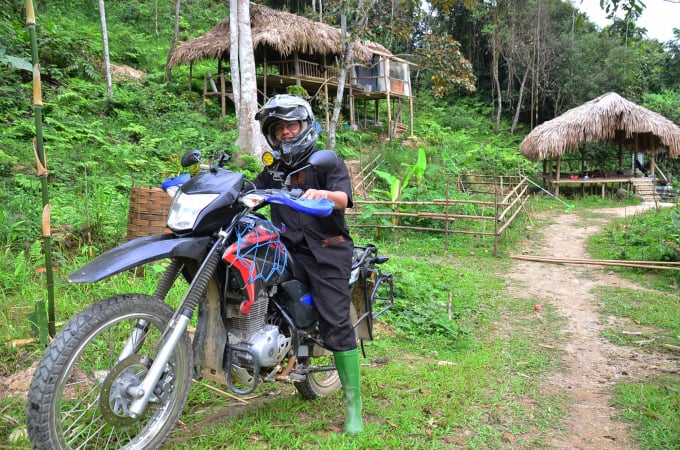
Hoang Quoc Thanh 'the great doctor' next to his huts in the middle of the forest. Photo: Duong Dinh Tuong.
“Living in the forest can be happy or miserable depending on outlook of each person. I named this house ‘Leisure’ because once you enter, you will find the pace of life slows down, all greed, anger and vice gone, like a calm water surface. Just head downtown and your head will be shaken by many aspects of life again.
“If the amount of money I poured in here is instead invested in the stock market or real estate, I would have earned a lot, but then I would only have enriched myself and even harmed society, because with land being bought and sold again and again to create the difference in price, how can poorer people acquire any? The land you are sitting on is a buffalo grazing field, with a lot of sunshine, so I grow light-loving plants like rosemary, and over there is a multi-layered forest where I plant velvet plants, multiflorous knotweeds and mulberries. Everything is determined by the ecosystem. Come on, let's visit the forest together!"
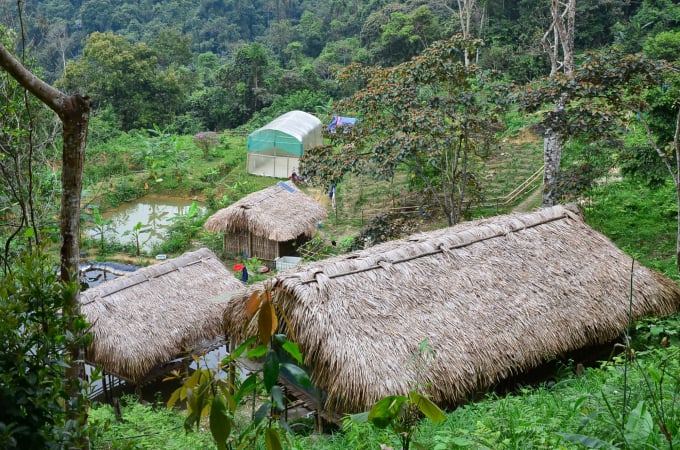
The huts are Thanh's living room, dining room and warehouse. Photo: Duong Dinh Tuong
When I rushed ahead Thanh called out, telling me to stay behind so that he could go ahead while waving a stick, stopping the poisonous snakes from biting. Moving under the cool canopy of the forest, he showed me the velvet plants and the Paris polyphylla interspersed everywhere in the landscape.
As a master in banking and financial economics, he used to work as an expert in setting up the ISO 9000 and VietGAP systems, but when he noticed that these certificates can be faked too easily, he got frustrated. Meanwhile his wife's family in Yen Bai was in the pharmaceutical industry, so Thanh began to learn about this profession, studied to become a doctor and created the Khai Tam brand ten years ago. During the process of importing medicinal herbs he discovered startling facts, for example that herbicides are sprayed on artemisia, partly to dry the outsides quickly while keeping the insides wet for weight gain and partly to shorten the cultivation time. Many precious medicinal herbs when purchased are only corpses because all of its medicinal properties have been dried out. In addition, the origin of the herbs often cannot be traced.
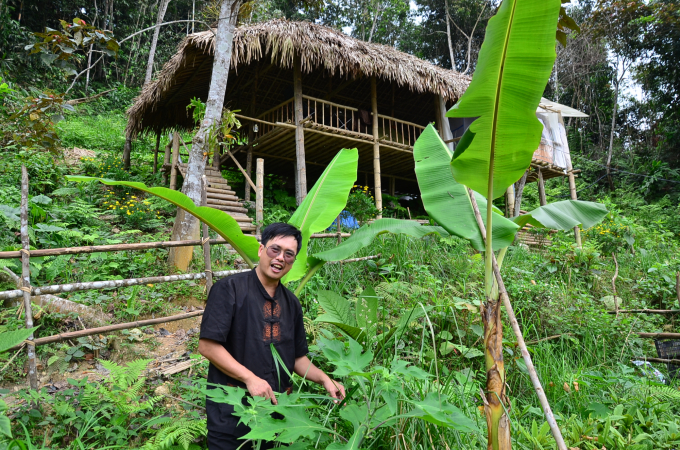
The medicinal herb garden in front of the main hut. Photo: Duong Dinh Tuong.
Thanh does not trade in medicinal herbs for quantity anymore. Instead he encourages farmers to grow for trade, even lending them seedlings then deducting the costs after harvest. This method has very low productivity because clean planting relies on the entire ecosystem, but the neighbouring region's forest has been destroyed, all the types of birds are gone, pests attack but he cannot use pesticides. Moreover, farmers mainly apply the monoculture method to grow medicinal herbs, which is not sustainable.
“Farmers who keep on hunting wild animals and birds will be attacked by pests and crops, then will have to use a lot of poison, which in turn causes harm to themselves. Products made according to that method are sold very cheaply, so they stay poor forever. In order for a product to have value it must satisfy the needs of society, the highest of which is health.
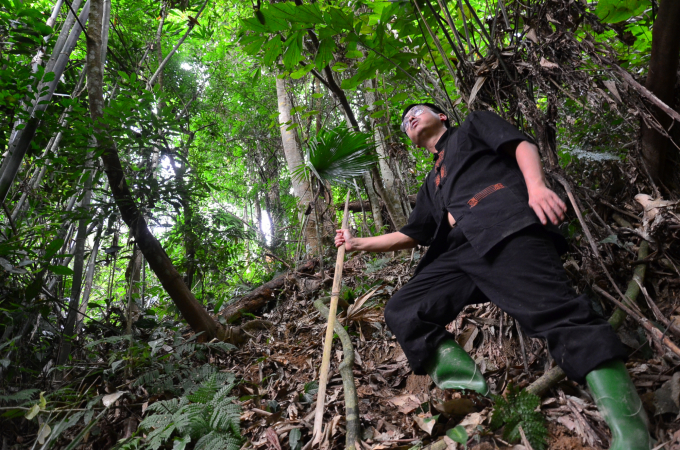
Thanh on his way to the forest. Photo: Duong Dinh Tuong.
That's why he planted his own garden. The first one was in Ta Phin, Sa Pa (Lao Cai), where he joined hands with farmers to grow medicinal herbs, but as it become more expensive they had to sell the herbs and abandon the land. Then one day he visited a lemongrass area in Lam Binh district, Tuyen Quang province, and was surprised to find so many forests there. From Phuc Yen pass onwards he could see many coucals, which means many snakes, and with many snakes comes many frogs, signalling a very healthy ecosystem. Seeing that the province and district leaders were determined to protect the forest, he decided to buy five hectares of productive forest but with an area of natural forest in Phuc Yen commune in early 2021 to grow medicinal herbs.
Farmers usually struggle with this type of land because it is illegal to cut down trees, and even if they secretly cut down trees to grow more acacia and eucalyptus exploitation is forbidden, so they don't know what to do other than collecting a few bamboo shoots every year. But this land suits his idea perfectly, the model of doing nothing: no plowing, no fertilizing, no medicine, no watering, just planting medicinal plants.

Thanh next to a Paris polyphylla plant grown in the forest. Photo: Duong Dinh Tuong
Multi-layered forests store and regulate water while fallen leaves can be made into manure. When growing a variety of medicinal herbs in small quantities Mother Nature balances herself: birds help to catch pests and snakes help to catch mice. To attract more birds he also planted papayas to provide ripe fruit as food for them. After one hectare of experimental planting to test the soil and the ecosystem and one dry season of doing nothing, the plants survived. This year he will plant the remaining four hectares.
“Economically you have to find the plants with the lowest risk. The ones I choose to plant are for the domestic market, not for export to China. I also do not sell to pharmaceutical companies but to end consumers, although I have a choice of customers because it is a clean and high-class product.
“When there was no internet and the world was flat growing medicinal herbs would not be profitable, but now I only need to take care of the plants, then people in Hanoi and Saigon will know right away through the clips I post on Facebook or Zalo and order them.” Thanh has enough solar power to use laptops and phones, without pulling electricity from the grid, because it's easy to cause short circuits and thus result in a fire when encountering wind and rain.
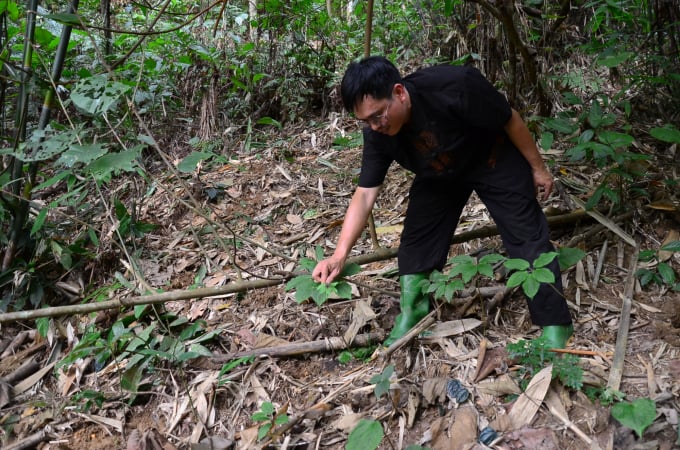
Medicinal plants planted under the forest canopy. Photo: Duong Dinh Tuong.
To be successful you must choose a short-term plant like velvet plant, which is ready for harvest in only six months. 1 kg of dry velvet is sold retail at 300,000 VND/kg, wholesale at 200,000 VND/kg, so you only need to plant 1,000 plants to make a profit of 2-3 million/month. As for long-term plants such as multiflorous knotweeds and mulberries, mulberries seeds are only 1,000 VND/plant, so planting 2,000 trees will cost 2 million VND, which is insignificant compared to the money put on alcohol. If however in the fifth year each root is harvested for 5kg on average, with a retail price at 300,000 VND/kg and wholesale at 100,000 VND/kg, equivalent to 500,000 VND/root, 2,000 plants equal 1 billion dong in profit.
“I don't plant dong quai because after twelve months, if I don't harvest in time, the roots will rot, so there is a lot of pressure on the output, while the longer the mulberries are left, the more expensive they become. I do not calculate by units of hectare because that would be monocultural. Instead I calculate by number of plants and recommend that farmers should not overplant, not to be greedy otherwise there would be a surplus.”
Thanh's garden plays not only an economic role but also a conservation one. So far he has collected ten precious medicinal herbs including stevia, mulberries, Desmodium styracifolii, wind ginger, Kaempferia galanga L., and Crinum latifolium. The goal in the next two to three years is to acquire approximately 200 types. “During the process of studying traditional medicine I found that my education often did not have many field trips, so every summer when I have free time I travel around everywhere to take pictures with the desire write a book on Southern Medicine.
“For plants like the Paris polyphylla I hired a guide for 300,000 VND to look around all day in an old forest but still I couldn't find it. In the old days images were limited, so although many traditional medicine doctors knew how to use dry medicine, when asked about fresh plants they did not know what the leaves and flowers looked like. Therefore I hope that the garden will be an experiential site for many students so that they can have a glimpse of a career path towards Southern Medicine in the future.”
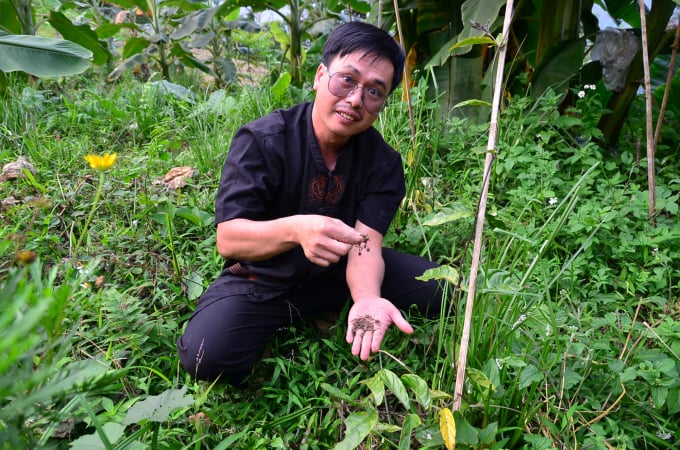
Checking the humus of the soil. Photo: Duong Dinh Tuong
Taking a sip of 300-year-old Shan Tuyet tea, then looking out at the forest in front of him, Thanh continued, "When I sit and drink tea, I listen to the sounds of free birds singing, which is entirely different from birds in cages. I want to prove how beautiful the forest is, so I will build a farmstay to welcome visitors, but now I will have to breathe life into this land by planting a garden of ancient rose varieties in Sa Pa - Van Khoi roses - as a check-in location. I will wait a few years so when the forest regenerates itself and becomes even more beautiful, I can build bungalows."
Wandering around the forest path, Thanh is so adored by the locals that he now has three adoptive fathers: a Tay here, a Hmong in Yen Bai and a Red Dao in Lao Cai. Each person taught him valuable indigenous knowledge such as making medicine and making tea. “I only bought five hectares but there will be twenty-one hectares of forest gardens because next week the eight neighboring households will build bamboo fences and plant the same plants that I am growing.
“I don't sell or donate seeds, I only direct customers to a place to buy. I don't stockpile, but will teach them how to sell plants themselves. In the future this village of Phuc Yen will be one of natural forests. The happiest day of my life was when my child asked me where I was going and I answered that "Dad is going to plant trees to make forests."
Translated by Nguyen Hai Long
/2025/06/17/3942-2-143243_548.jpg)
(VAN) Recently, in Sweden, the Secretary of the Binh Dinh Provincial Party Committee presented the Investment Registration Certificate for the 'Polyester Fabric Recycling Complex' project to SYRE Impact-AB Company.
/2025/06/12/3721-2-202745_83.jpg)
(VAN) TH made an impression at Seoul Food 2025 with its line of natural beverages, paving the way for Vietnamese food products to enter the South Korean market.
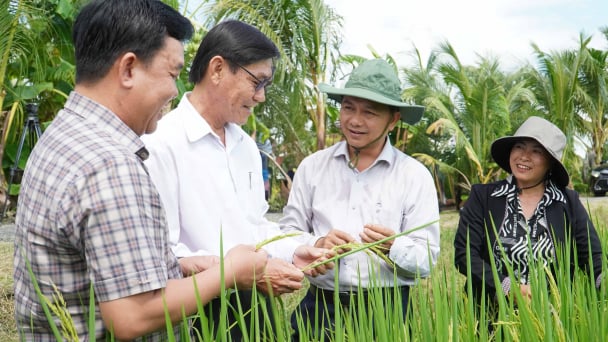
(VAN) Soc Trang's success in rice exports stems from a strategy of developing fragrant and specialty rice cultivation areas and standardizing production toward low-emission practices.
/2025/06/11/1311-5-120811_839.jpg)
(VAN) The pig farming industry is facing the challenge of comprehensive restructuring to meet requirements for quality, safety, traceability, and market expansion both domestically and for export.

(VAN) Vietnam considers participating in ALGROALBA in order to expand agricultural production, coordinate the assessment and effective exploitation potential land.
/2025/06/05/5314-1-184727_407.jpg)
(VAN) From seemingly worthless fish scales and skin, enzymes and lactic ferments can transform by-products into peptides, opening a sustainable, effective business direction and elevating Vietnamese seafood.

(VAN) TTC AgriS and IFC signed a strategic partnership to develop a sustainable agricultural value chain, aiming to achieve the Net Zero target by 2035.